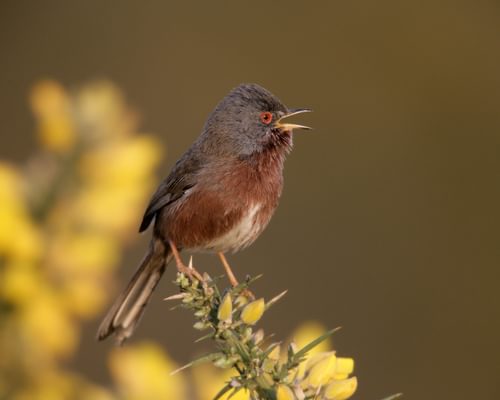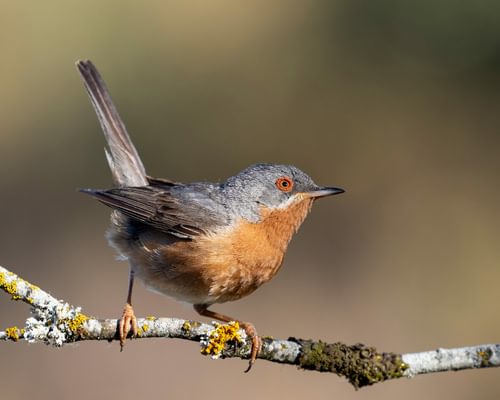Balearic Warbler
Least ConcernCurruca balearica
Visual Identification
Appearance
The Balearic Warbler is a small, slender bird with distinctive plumage. Males have a blue-grey head and upperparts, contrasting with a white throat and pinkish-brown underparts. Their tails are long and often held cocked.
Females are more subdued in colouration, lacking the blue-grey tones and appearing overall browner. Both sexes have a thin black bill, pink legs, and a prominent red eye ring, which becomes more vibrant during the breeding season.
Size
Length
11cm to 12cm
Wingspan
15cm to 17cm
Weight
8g to 12g
Habitat and Distribution
Habitats
Woodland
Garden
Wetland
Coastal
Urban
Farmland
Grassland
Desert
Tundra
Rainforest
Mountain
Savanna
Distribution
The Balearic Warbler is endemic to the Balearic Islands, specifically Mallorca, Menorca, and Cabrera. It inhabits Mediterranean scrubland, known as garigue or maquis, characterised by low, dense vegetation.
These birds prefer coastal areas and hillsides with abundant shrubs like rosemary, cistus, and juniper. They are non-migratory and maintain their presence in the Balearic archipelago year-round.
Elevation Range
Sea level to 1,200 meters
Climate zones
Mediterranean
Distribution Map
This map gives you a rough idea of where you might spot a Balearic Warbler. The coloured areas show countries where these birds have been seen.
A few things to keep in mind:
- Birds might not be everywhere in the coloured areas, for example, they may be present around the coast of that country
- Where birds live can change with seasons and available food
- This map is quite simple - it doesn't show exact locations
We're working on making our maps even better! Soon, we hope to show you:
- More detailed maps for bigger countries, including state and region
- How birds move around during different seasons
Distribution by Region
Behaviour and Ecology
Bird Attributes
This feature is in beta. We'd love your feedback to improve it!
Share your thoughtsBird Attributes Explained
Our bird attributes system rates various aspects of a bird's capabilities on a scale of 0-100, based on data from field observations, scientific studies, and expert knowledge.
Attribute Categories:
- Agility: Manoeuvrability, speed, and grace in flight or movement.
- Strength: Physical power, often correlating with size and hunting abilities.
- Adaptability: Ability to thrive in various environments or changing conditions.
- Aggressiveness: Territorial behaviour and assertiveness, particularly during breeding seasons.
- Endurance: Stamina, often seen in migration patterns or foraging behaviours.
Understanding the Ratings:
- 0-20: Very Low
- 21-40: Low
- 41-60: Average
- 61-80: High
- 81-100: Very High
Remember, these attributes are relative to other bird species and don't necessarily indicate superiority.
Hover over the icon next to each attribute for more information.
Tap the icon next to each attribute for more information.
Agility
Reflects the bird's manoeuvrability, speed, and grace in flight or movement.
The Balearic Warbler demonstrates high agility, constantly flitting through dense vegetation and foraging with nimble movements. Its small size and ability to navigate complex scrubland habitats suggest excellent manoeuvrability.
Strength
Indicates the bird's physical power, often correlating with size and hunting abilities.
As a small passerine weighing only 8-12 grams, the Balearic Warbler has limited physical strength. Its diet of small insects and occasional berries doesn't require significant strength, and its lightweight build is more suited for agility than power.
Adaptability
Represents the bird's ability to thrive in various environments or changing conditions.
This species shows remarkable adaptability, thriving in the specific Mediterranean scrubland of the Balearic Islands. Its ability to survive without drinking water, obtaining moisture from prey, and its year-round residency in a limited range demonstrate high adaptability to its niche environment.
Aggressiveness
Measures the bird's territorial behaviour and assertiveness, particularly during breeding seasons.
While males become more conspicuous and territorial during breeding season, the Balearic Warbler is generally not known for aggressive behaviour. Their secretive nature and focus on avoiding predators suggest a relatively low aggression level compared to many bird species.
Endurance
Reflects the bird's stamina, often seen in migration patterns or foraging behaviours.
The Balearic Warbler's endurance is moderately high, as evidenced by its constant activity and foraging behaviour. Its ability to survive in sometimes harsh Mediterranean conditions and maintain territories in dense scrubland indicates decent stamina, though its small size limits extreme endurance feats.
Diet
These warblers primarily feed on small insects and spiders, which they glean from leaves and branches. They occasionally supplement their diet with small berries, especially during autumn when insect availability decreases. It will also take flies in flight.
Behaviour
Balearic Warblers are active and restless birds. They constantly flit through dense vegetation, foraging low in shrubs, often with their tails raised.
During the breeding season, males become more conspicuous, perching prominently to deliver their melodious songs.
Vocalisation
Nesting & Breeding
Breeding season for Balearic Warblers typically begins in March and extends through June. Males establish territories and attract females with elaborate song flights and displays.
Nests are well-concealed, cup-shaped structures built low in dense shrubs, often cistus or rosemary. Females lay 3-5 eggs, which are pale with brown speckles.
Incubation lasts about 12-13 days, and the female primarily carries out the process. Both parents feed the nestlings, which fledge after 11-12 days but remain dependent on the adults for several more weeks.
Lifespan
years
The Balearic Warbler typically lives for 3 to 5 years.
Like all birds, lifespan can be affected by factors including predation, habitat quality, disease, and access to food sources.
Conservation and Status
Global Conservation Status
The Balearic Warbler is classified as Least Concern, but it does face issues because of its restricted range and vulnerability to habitat loss.
Conservation efforts focus on protecting and managing its scrubland habitat, particularly from urbanisation and intensive agriculture in the Balearic Islands.
Birdwatching Tips
- Listen for their distinctive song, especially during spring mornings
- Look for movement in low, dense Mediterranean scrub
- Pay attention to their characteristic tail-cocking behaviour
- Visit coastal areas and garigue habitats in the Balearic Islands
Additional Information
Quick Facts
Other names:
Balearic Subalpine Warbler, Sylvia balearica
Family:
SylviidaePredators
Did You Know?
- The Balearic Warbler was only recognised as a separate species in 2001.
- It's one of the few bird species endemic to Spain.
- These warblers can survive without drinking, obtaining moisture from their insect prey.
Was this bird profile helpful?
Your feedback helps us improve our content
Thanks for your feedback!
Your input helps us improve our content.
Community Experience
Community Ratings
No ratings yet - be the first to rate this bird!
Latest Community Reviews
No reviews yet
Sign in to be the first to review
Community Reviews
Create Your Free Account Welcome Back!
Join our community to rate birds and share your experiences. Creating an account is completely free and only takes a minute. Sign in to your account to rate birds and share your experiences with our community.
Your information is secure and will never be shared.
By creating an account, you agree to our Privacy Policy.
Similar Birds
References
- 1 2 3
website: BirdLife International. 2017. Sylvia balearica (amended version of 2016 assessment). The IUCN Red List of Threatened Species 2017: e.T22734798A113119361.
View source

